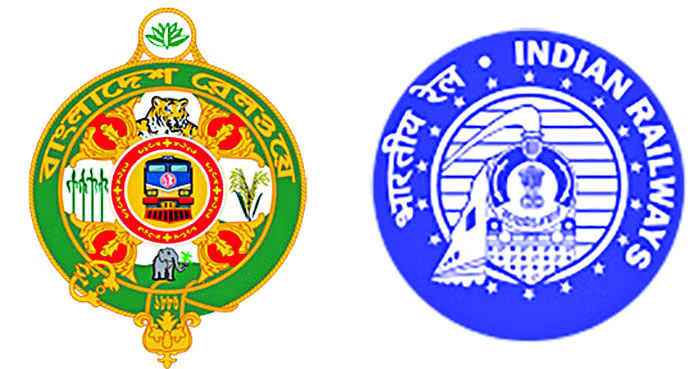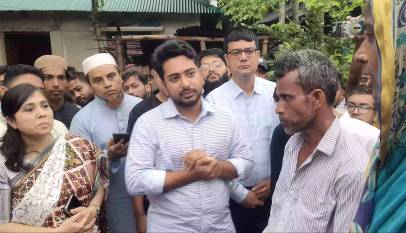Who will benefit by Indian use of BD railways?
Asifiqbal Thakoor, Delhi: Bangladesh and India have signed a memorandum of understanding to facilitate and improve connectivity with the northeastern states of India using Bangladesh’s railways. The neighboring country is going to take this opportunity due to its geographical location. If they get such an opportunity, Bangladesh will benefit – the question has been raised in the concerned circles.
The MoU was signed after a bilateral meeting between Bangladesh Prime Minister Sheikh Hasina and Indian Prime Minister Narendra Modi at Hyderabad House in New Delhi, India on June 22 (Saturday). The MoU includes – the introduction of a new inter-country train service between Rajshahi and Kolkata and India’s rail-transit in Bangladesh.
Earlier India planned to build a set of railways through Bangladesh. The country has already reportedly approved Final Location Survey (FLS) for 14 railways. The new railways will connect Nepal besides Bangladesh. In this plan, there will be 861 km of railway in Bangladesh.
In a press conference after the signing of the memorandum of understanding, Indian Foreign Secretary Vinay Mohan Kwatra said that important discussions were held between the two leaders to launch a railway connection from one Indian state to another using the territory of Bangladesh. A goods train will be trial run from Gede-Darshana to Haldibari-Chilahati Cross-Border Interchange Point using Bangladesh Railway route. It could happen sometime next July. It will help in sub-regional connectivity with Bhutan.
However, India will benefit more by using Bangladesh’s railways. On the other hand, communication experts have expressed apprehension that the loss may be more than the gain of Bangladesh. They say that even though there was an agreement on the naval corridor earlier, Bangladesh could not benefit much. Again, even if Bangladesh gains in passenger transport by train, it will not be able to gain much in goods transport.
With the signing of the Memorandum of Understanding, it was announced that after 77 years, the resumption of international train service between Rajshahi and Kolkata. This will be the fourth international train running between Bangladesh and India. Apart from this, the important aspect of this memorandum is the initiative to reduce the distance and time of the 12 routes of seven states known as Seven Sisters from Kolkata in India using the railways of Bangladesh. As a result, the country will get great benefits in passenger and goods transportation.
According to the data of Google Maps, at present, the railway distance from Kolkata to Agartala through the ‘chicken neck’ corridor using the territory of India is about 1600 km. It takes 31 to 36 hours to pass. The distance will be reduced to about 500 to 550 km to pass through Dhaka through Bangladesh. It will take 11 and a half to 12 hours to cross.
According to a report of the daily newspaper The Telegraph published from Calcutta, India, on June 14, there is currently only one railway connecting the Northeast with the rest of India, which has become the Siliguri Corridor. This strategically important corridor is known as ‘Chicken Neck’. It is the narrowest land in the subcontinent. Chicken Neck is connected to Nepal to the north and Bangladesh to the south. On the other hand, its distance from China border is 170 km.
A set of railways through Bangladesh will facilitate and improve railway communication with the North-Eastern states of India. It will add Nepal besides Bangladesh. Under the new plan, there will be 14 sections of a total length of 1,275 km of railway. Out of this, 861 km will be inside Bangladesh. There will be 202 km in Nepal and 212 km in the North East.
The Telegraph also reported that New Delhi’s plans were made easier by the Bangladesh government’s decision to allow India to build railways within the country. According to Indian Railway sources, a total of 861 km will be surveyed in Bangladesh, 202.50 km in Nepal and 212 km in North Bengal and North Eastern regions.
When asked about the matter, communication expert and Bangladesh University of Engineering (BUET) professor Md. Hadiuzzaman told that if they call Agartala from Kolkata, then their distance and cost will be reduced. This is their main purpose. As a result, India will benefit greatly.
“Each and every route of India’s connectivity should be thoroughly scrutinized by us. We should take into account the section and capacity of the railway. As they will benefit greatly financially and their capacity to transport passengers and goods will increase, we should negotiate very well there. How we can monetize beyond the section and railway capacity will have to be looked at very carefully. It should not be that only India will go through us and create connectivity with Bhutan. In order for us to be the beneficiaries of that connectivity, we also need to look and think deeply. It should be taken into account first so that we don’t have to incur losses while giving benefits to India.’
Communication expert and professor of civil engineering department of BUET M Shamsul Haque said that India wants to create a new area of communication through the establishment of rail-link through Bangladesh, which is actually an ‘open door’ policy. The key to developing this relationship is to provide opportunities for equality-based development on the basis of fairness. Some will go forward, some will go back – this policy does not actually stabilize development.
“Bangladesh is in an excellent geographical position in terms of development of regional relations. Our coast line provided opportunities for trade with the outside world. But India’s neighboring Seven Sisters, Nepal or Bhutan do not have the opportunity. In that place, Bangladesh can take advantage of its geographical position.
On the question of how Bangladesh will benefit from rail-transit, he said, ‘India needs to do a complete survey for the railway through which India wants to build the internal communication infrastructure of Bangladesh. When a train from another country enters the country, there will be operational disruption of the train. Then there is the cost of security. How much will my infrastructure depreciate, I need to calculate it every year. Nepal and Bhutan should also get the benefits that India gets. It should also be seen that only one country does not get advantage. When I sit at the negotiating table to determine the fares, we need to know what our share of passenger or cargo rail traffic will be. Because we see, our share in seaport and sea port is not fair.
A survey was conducted many years ago under the supervision of Professor Dr. Rahmatullah. Bangladesh had the potential to get $ 1 billion every year through the establishment of international communication.
Sardar Shahadat Ali, director general of Bangladesh Railway, said, “It came here for two reasons; One is a train from Rajshahi to Kolkata, another is rail-transit or transshipment. A demand of Rajshahi residents for a long time was that they would go to Kolkata by train from Rajshahi via Darshana. There is no problem in our existing railway line to run this train. With the broad gauge engine we have, we can run 1/2 train 2/3 days a week. But we have carriage problem. That is, there is no broad gauge coach. At this initial time, they should contact India and make arrangements to run them with a coach. As we are importing 200 broad gauge coaches from India, after 8/9 months we will not have this problem. This will increase the revenue of both countries. We need more. The distance from Rajshahi to Darshana is less than the distance from Darshana to Calcutta or Sealda. As a result, we will get more revenue here.
Regarding rail-transit or transshipment, he said, Agartala route is outside the interchange point we have with India; Trains have been run through this route, trial run has been done. Through this route India will be able to transport goods whenever it wants from Chittagong port. We have taken that action. Kulaura-Shahbajpur route is in progress. The suggested route is Feni-Belunia. Burimari-Changrabandha, Mogulhat-Geetlgao routes are also being considered.
There will be no direct transit to Kolkata through Agartala-Akhaura. Because, meter gauge track from Akhaura to Tongi. We are thinking of doing Inland Container Depot or ICD at Nimtali after crossing Padma Bridge. From there the goods will be transshipped to Kolkata. Whichever freight or passenger train runs from India, we will get revenue. The Tariff Commission will fix a fare. It will benefit the state financially. There is no opportunity to unilaterally profit here. However, we get seven-eight times more profit in freight trains than in passenger trains.
On June 10, Jatiya Sangsad Railway Minister Md. Zillul Hakim said that the income of railways in other countries of the world mainly depends on the income of freight trains. While the average income of a passenger train is Tk 3 lakh to Tk 3.5 lakh, the average income of a freight train is around seven to Tk 8 lakh. At present, the capacity of each passenger train of Bangladesh Railway is about 100-120 percent. But only 20-25 freight trains run.
Rare Israeli airstrike in Beirut kills Hezbollah commander and more than a dozen others
International Desk: Israel launched a rare airstrike that killed a senior Hezbollah milita…








